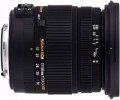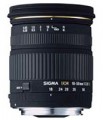Main function
The general purpose is rather conditional, and in fact the use of optics is not limited to the claimed direction — it all depends on the skills and imagination of the photographer. However, information about the specialization can greatly facilitate the choice. Considering such original options as a
cinema lens and
a multifunctional.
—
Architectural. Lenses designed primarily for shooting buildings. Most of these models are equipped with the Tilt-Shift system (see below). In this case, this function is intended to correct the perspective when shooting tall buildings. In a photograph taken with a normal lens, straight lines can turn out to be curved, which is unacceptable in cases where an accurate representation of the building in the picture is required. Using the Tilt-Shift system allows you to avoid this phenomenon and get a reliable image that does not require additional correction in a photo editor.
—
Landscape. In this case, landscape lenses include short-focus (wide-angle) lenses, which, according to test results, provide good image sharpness. In other words, not all “wide-angles” are classified as landscapes, but only those that are actually capable of providing a clear, sharp image.
—
Portrait. The hallmarks of a classic portrait lens are: first, the fixed focal le
...ngth, which is usually over 50mm (35mm equiv.); secondly, high aperture (most often not lower than f / 2.8, although occasionally there are exceptions). This combination of characteristics allows you to shoot portraits with beautiful background blur, placing the camera at a fairly significant distance; the latter can be useful in studios where additional lighting equipment is used — it is advisable to install the camera behind lighting fixtures so that it does not give a shadow. Speaking of a fixed focal length, it is worth recalling that "fixes" are simpler, lighter and cheaper than zoom lenses, and the ability to adjust the magnification when shooting portraits is rarely required — most often you can completely get by with "zoom with your feet".
— Multifunctional. This direction includes lenses of a universal type (see above), offering the buyer a good value for money; in other words — multi-purpose models with good performance and at the same time relatively inexpensive (namely, "comparatively", the actual price can be quite high). When choosing models in this category, the quality of filming was evaluated according to the results of real tests.
— Film lens. The main feature of cinema lenses is the ability to fine-tune the aperture. The aperture can be closed / opened by 0.1 or even 0.01 mm, while in photo lenses the aperture setting step cannot be less than 1 mm. Additionally, in cinema lenses, aperture is expressed by a T-number, and in photographic lenses, an F-number is used. The operator can shoot multiple cinema lenses with the same aperture, without the need to change the lighting. And when using photo lenses with the same aperture, you often have to adjust the lighting for each optic separately. Cinema lenses are meant to be shot from a tripod, which is reflected in their design features and design — such models are usually larger and heavier than their counterparts for photography.System
The system indicates which brand of cameras this lens is designed for. Manufacturers of photographic equipment often use original mounting systems in their cameras that are not always compatible with each other; therefore, for normal use, the lens must be originally designed for the corresponding system. At the same time, note that the actual compatibility will also depend on the mount (see "Bayonet (mount)"). At the same time, one system often includes several mounts (for example, Canon and Nikon); it happens vice versa — one mount can be used in several systems at once (for example,
Micro 4/3 is used by both Olympus and Panasonic). In general, the optimal selection order is as follows: first clarify the compatibility of the lens with the system, then with a specific mount.
Also note that third-party manufacturers (who do not produce cameras and deal only with lenses) often produce models designed for several different systems at once. Such compatibility can be achieved both through a set of adapters (included in the package or sold separately), and through the release of different modifications of the same lens, differing only in mounts. The features of each such model should be specified separately.
Mount
The type of mount used to connect the lens to the camera. The name comes from the English "bayonet", meaning "bayonet" and a bayonet-type connection. Bayonet mounts are used in the vast majority of modern digital cameras due to their reliability and ease of use.
Full compatibility of the lens with the camera is guaranteed only if the types of their mounts match. Some mounts are compatible with each other via adapters, but such a connection can limit the capabilities of the lens (for example, it will make it impossible to use autofocus) and is generally not considered optimal. It is worth considering that within the same system (see above) different mounts are often used, which are also incompatible with each other.
So, the manufacturer Canon has mounts
EF-M,
EF-S,
EF,
RF,
RF-S. Leica has
Leica M,
Leica SL,
Leica TL. Nikon has
Nikon 1,
Nikon F,
Nikon Z in its arsenal. Pentax optics are equipped with
Pentax 645,
Pentax K,
Pentax Q. Samsung uses
NX-M and
NX mounts. Sony models include
Sony A and
Sony E. In addition, there are other types of mounts on the market - both branded (
Fujifilm G,
Fujifilm X,
Hasselblad H,
Sigma SA) and universal (
Four Thirds (4/3),
Micro 4/3).
Note that there are lenses that are declared compatible with several mounts at once. This “omnivorousness” can be realized in different ways. For example, some models have a non-standard mount on the lens body, and compatibility with various mounts is ensured through the use of adapters; These adapters can be included in the delivery set or purchased separately. Another option is that the lens is available in several separate modifications, each for its own mount. These details should be clarified before purchasing.
Viewing angles
This parameter determines the size of the area of the scene being shot that falls into the frame. The wider the viewing angles, the larger the area the lens can capture in one shot. They are directly related to the focal length of the lens (see "Focal length"), and also depend on the size of the specific matrix with which the optics are used: for the same lens, the smaller the matrix, the smaller the viewing angles, and vice versa. On our website, in the characteristics of optics, viewing angles are usually indicated when used with the matrix for which the lens was originally designed (for more details, see "Matrix Size").
Autofocus drive
A type of drive that ensures the movement of lens structural elements during automatic focus. Currently, the following types can be used:
—
Ultrasonic motor. The most advanced type of drive to date. Ultrasonic motors are much faster than conventional motors, provide higher accuracy, consume less power and are virtually silent. However, their cost is quite high.
—
Stepper motor. Drive control focal length and zoom (zoom). This type of motor is used for the most part only in full-size digital cameras. Among the advantages of a stepper motor, one can note: high reliability and accuracy of operation; in addition, it does not require power supply to maintain focus and zoom. Of course, stepper motors are not without drawbacks. Among the minuses can be identified: slow speed and increased noise. Additionally, a stepper motor is characterized by large dimensions and a rather large weight, which physically does not allow this type of drive to be integrated into the optics of mobile phones and ultra-compact cameras.
— Motor. In this case, an electric
motor of a traditional design is meant. Such drives are simple and, as a result, inexpensive. Their disadvantages are the relatively low speed of operation, as well as the noise produced during this; the latter can sometimes be critical — for example, when shooting wildlife. Recently, designers have been us
...ing various tricks to neutralize these shortcomings, but in general, the characteristics of conventional motors still remain relatively modest.
— Is absent. The complete absence of an autofocus motor in the lens. Focus such optics can be carried out either by the “screwdriver” system, or strictly manually (for more details on both options, see below).Internal focus
Lenses using the
internal focus system. In such optics systems, focus is carried out only due to the movement of elements inside the lens body; the outer parts remain completely fixed and the size of the lens does not change. This provides additional convenience — in particular, it allows you to easily use petal hoods and those types of filters for which the correct position on the lens is important (in particular, gradient ones). In addition, the absence of moving elements from the outside has a positive effect on security and resistance to dust / precipitation (although the specific degree of dust and water protection may be different).
Image stabilization
The presence in the lens of its own
image stabilization system. Such a system includes gyroscopes and movable lenses that compensate for small tremors of the lens and prevent the appearance of “shake”. Stabilization is especially relevant when shooting handheld, especially at slow shutter speeds and/or at long distances with high magnification: it is in such conditions that “shake” affects the quality of the image the most. At the same time, it should be taken into account that the presence of a stabilizer significantly affects the weight, dimensions and, above all, the price of optics; at the same time, some modern cameras have their own stabilization systems (due to matrix shift). Therefore, it makes sense to choose a lens with this function in the case when maximum protection against “shake” is of fundamental importance.
Design (elements/groups)
The number of elements (in fact, the number of lenses) included in the design of the lens, as well as the number of groups in which these elements are combined. Usually, the more elements provided in the design, the better the lens handles with distortions (aberrations) when light passes through it. On the other hand, numerous lenses increases the dimensions and weight of the optics, reduces light transmission (for more details, see "Aperture") and also puts forward increased requirements for the quality of processing, which affects the cost of the lens.
Filter diameter
Thread diameter for installation on the filter lens. Light filters are devices for changing the parameters of the light flux entering the lens. They can be used for highlighting individual colours, coloring the entire image in one colour, darkening the image, correcting colour temperature and light balance, shooting in the infrared range, etc. Also, a light filter can play the role of protection against pollution. For successful installation on the lens, the diameter of the filter must match the diameter of the filter specified for this model of optics.

